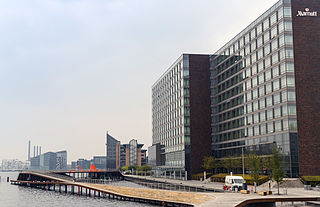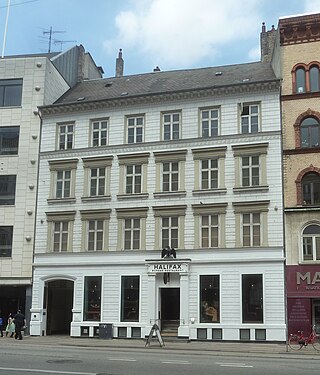
In livestock agriculture and the meat industry, a slaughterhouse, also called an abattoir, is a facility where livestock animals are slaughtered to provide food. Slaughterhouses supply meat, which then becomes the responsibility of a meat-packing facility.

The meat-packing industry handles the slaughtering, processing, packaging, and distribution of meat from animals such as cattle, pigs, sheep and other livestock. Poultry is generally not included. This greater part of the entire meat industry is primarily focused on producing meat for human consumption, but it also yields a variety of by-products including hides, dried blood, protein meals such as meat & bone meal, and, through the process of rendering, fats.

The Meatpacking District is a neighborhood in the New York City borough of Manhattan that runs from West 14th Street south to Gansevoort Street, and from the Hudson River east to Hudson Street. The Meatpacking Business Improvement District along with signage in the area, extend these borders farther north to West 17th Street, east to Eighth Avenue, and south to Horatio Street.

Valby ( ) is one of the 10 official districts of Copenhagen Municipality, Denmark. It is in the southwestern corner of Copenhagen Municipality, and has a mixture of different types of housing. This includes apartment blocks, terraced housing, areas with single-family houses and allotments, plus the remaining part of the old Valby village, around which the district has formed, intermingled with past and present industrial sites.

City Hall Square is a public square in the centre of Copenhagen, Denmark, located in front of the Copenhagen City Hall. Its large size, central location, and affiliation with the city hall makes it a popular venue for a variety of events, celebrations and demonstrations. It is often used as a central point for measuring distances from Copenhagen.

Gammeltorv is the oldest square in Copenhagen, Denmark. With adjoining Nytorv it forms a common space along the Strøget pedestrian zone. While the square dates back to the foundation of the city in the 12th century, most of its buildings were constructed after the Great Fire of 1795 in Neoclassical style. Another dominating feature is the Caritas Well, a Renaissance fountain erected by King Christian IV in 1610.

Nytorv is a public square in the centre of Copenhagen, Denmark. Together with the adjoining Gammeltorv it forms a common space, today part of the Strøget pedestrian zone. The square is dominated by the imposing Neoclassical façade of the Copenhagen Court House, which from 1815-1905 also served as the City Hall.

Istedgade is a 1-kilometer straight street in the district of Vesterbro in the Danish capital, Copenhagen. It starts at Copenhagen Central Station and runs parallel to Vesterbrogade to Enghave Plads and Enghaveparken. From the station in the cheap hotel district, it runs through the porn, prostitution and drugs area to modern Vesterbro, where 1900s tenement style blocks have undergone significant modernisation. It is generally considered the heart of Vesterbro and was a main traffic artery until 2013 where the street had traffic reducing measures installed.

V1 Gallery is a contemporary art gallery located in the Meatpacking District of Copenhagen, Denmark. It was founded in 2002 by designer Jesper Elg and photographer Peter Funch. V1 Gallery gained international notability by being the first art gallery in Scandinavia to exhibit international street art pioneers such as Banksy (UK) and Eine (UK), the Faile artist collective (US/JAP), Futura 2000 (US), Zevs (FR) and OBEY / Shepard Fairey (US). The gallery has been listed as "Copenhagen's coolest art gallery" by The New York Times, and listed in ArtNet's "Best contemporary galleries in Europe".

DGI-byen is a facility that houses various spa facilities, restaurants, hotels, conference facilities, a bowling alley, flexible multi-centres, sports clubs, a superellipse shaped swimming pool and Vandkulturhuset,, located in central Copenhagen, Denmark.

JBS S.A. is a Brazilian company that is the largest meat processing enterprise in the world, producing factory processed beef, chicken, salmon, pork, and also selling by-products from the processing of these meats. It is headquartered in São Paulo. It was founded in 1953 in Anápolis, Goiás.

Halmtorvet is a public square in the Vesterbro district of Copenhagen, Denmark. It is located next to Copenhagen Central Station in front of the Meat District. The oblong square eventually turns into Sønder Boulevard, a broad street with a park strip in its central reserve, which continues to Enghavevej at Enghave station.

Kalvebod Brygge is a waterfront area in the Vesterbro district of Copenhagen, Denmark. The name also refers to a section of the Ring 2 ring road which follows the waterfront from Langebro in the north to the H. C. Ørsted Power Station in the south. The area is dominated by office buildings, Tivoli Conference Center, several hotels and the shopping centre Fisketorvet.

Øksnehallen is an exhibition space located on Halmtorvet in the Vesterbro district of Copenhagen, Denmark. The building is a former market hall, part of the Brown Meat District.
Labor rights in the American meatpacking industry are largely regulated by the National Labor Relations Board (NLRB), which regulates union organization. The Occupational Safety and Health Administration regulates the safety and health conditions applicable to workers in the American meat packing industry. According to scholars of the American meat packing industry, despite federal regulation through OSHA and industry oversight, workers in meat production plants have little agency and inadequate protections. Workers in the industry perform difficult jobs in dangerous conditions, and are at significant risk for physical and psychological harm. In addition to high rates of injury, workers are at risk of losing their jobs when they are injured or for attempting to organize and bargain collectively. Several of studies of the industry have found immigrant workers—"an increasing percentage of the workforce in the industry."

Vesterbro Pharmacy operated from 1795 to 1992 in the Vesterbro district of Copenhagen, Denmark. Its former buildings on Vesterbrogade, one facing the street and two in the courtyard on the rear, were listed in 1972; all three date from the second half of the 19th century.

Vigerslev Allé is a major artery in the Valby district of Copenhagen, Denmark. It runs from Enghavevej in the northeast to Hvidovrevej in Hvidovre in the southwest. The first part of the street runs east-west, following the south side of the main railway line through Copenhagen on its way to Toftegårds Plads, the largest square in Valby. It later passes under the S-train network's Ring Line at Vigerslev Allé station before continuing southwest to the Ring 2 ring road just before entering Hvidovre Municipality at Harrestrup Å in Vigerslevparken.
Kevin Anton Janus Bendix known professionally as Kevin Bendix is a Danish serial entrepreneur specializing in development of temporary urban culture.

Tietgensgade is a street in central Copenhagen, Denmark. It runs from H. C. Andersens Boulevard in the northeast to Kvægtorvgade at the Meat-Packing District in the southwest, linking Stormgade in the city centre with Ingerslevsgade and Halmtorvet/Sønder Boulevard in Vesterbro. The street follows the rear side of Tivoli Gardens and Copenhagen Central Station. The viaduct that carries it across the railway tracks at the central station is known as Tietgensbro. A series of staircases and lifts provides direct access from the viaduct to the station platforms.

The meat industry has been severely affected by the COVID-19 pandemic in the United States. Outbreaks of the virus took place in factories operated by the meat packing industry and the poultry processing industry. These outbreaks affected dozens of plants, leading to closures of some factories and disruption of others, and posed a significant threat to the meat supply in the United States. The damage the COVID-19 pandemic brought to the meatpacking industry was unexpected and resulted in a sharp reduction of meat processing and capacity reduction of meatpacking companies.
























